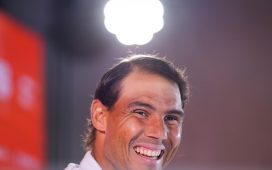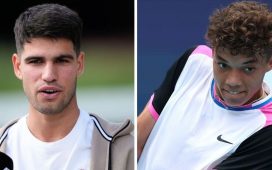In her pretournament news conference on Friday, the defending United States Open champion Naomi Osaka was asked about her early experience at tennis’ major championships.
“My first Slam was qualies here,” Osaka said of the Open’s 128-player qualifying tournament, which allows lower-ranked players a chance to earn one of the remaining coveted spots — 16 each for men and women — in the main draw. “But we don’t count qualies.”
Osaka lost in the second round of qualifying in 2015, but the official U.S. Open record book has no mention of that.
“At the end of the day, your career is measured by how many Grand Slam main draws you played in,” said Eric Butorac, the director of pro tennis operations and player relations for the United States Tennis Association, who as a player never qualified in singles at the Open. “People don’t look at the qualifying the same way they do a main draw match. It’s a real status thing.”
The difference between qualifying and main draw starts with prize money. A third-round loser in qualifying pockets $32,000, but a first-round appearance in the main draw nets a player a minimum of $58,000 this year.
Main draw players also receive perks such as a chauffer-driven Mercedes-Benz and $400 per day for living expenses. Qualifying participants get $300 per day and a shuttle bus from the U.S.T.A. Billie Jean King National Tennis Center to one of three New York City hotels.
One of the most coveted perks for main draw participants is a visit to the gift redemption center, or the so-called swag suite, next to the player lounge. There they receive $1,100 worth of merchandise, which might include a Herschel backpack, a silver Tiffany necklace (or card case), a Nordstrom gift card, Bose noise-masking earbuds or other luxury items.
For those who lose in the final round of qualifying, it can’t feel good to see an opponent walking around the grounds wearing a cashmere scarf, as a reminder that they just missed out.
“I get nauseous watching these last rounds of qualifying at a major,” the broadcaster Mary Carillo said. “The most pressure-fraught matches they may ever play will be in these rounds. I feel so much for these young kids who are trying to get into their first major. I see a lot of double faults in those matches.”
On Friday, the last day of qualifying, across 14 courts at the National Tennis Center, 64 players in 32 matches shared one goal: win and reach the main draw. Here are some of their stories.
3:25 p.m.
Jenson Brooksby d. Pedro Martínez
Starting an hour and a half late because of a rain delay, Brooksby, an 18-year-old Californian also known as J.T., won and became the only American man to reach the main draw through qualifying. Last year, Brooksby got a wild card into the main draw when he won the junior national championship in Kalamazoo, Mich. He lost in the first round to the Australian John Millman, who went on to upset Roger Federer in the round of 16.
Brooksby could have competed in Kalamazoo again this year, but he opted for the challenge of U.S. Open qualifying. He played before a packed house of more than 1,500 on Court 11.
“I just felt like I had worked so hard, I was a year older and I felt ready,” Brooksby said after he defeated Martínez, a 22-year-old from Spain, 6-3, 6-7 (4), 6-3. “Coming through qualies is incredibly tough. I’ve never played in front of a crowd this big.”
Brooksby led by 5-3 and served for the match at 5-4 in the second set, only to double-fault on break point. After a brief rain delay in which both players stayed on court, Brooksby dropped the tiebreaker. He then sat in his chair while Martínez called the trainer. Brooksby removed his baseball cap and repeatedly ran his fingers through his hair.
“He’s emotional,” his coach, Joe Gilbert, said. “This is probably the biggest match he’s ever played.”
Brooksby is expected to play collegiate tennis at Baylor starting in January, assuming he maintains his amateur status. That would mean turning down at least $58,000 in prize money here. As of Friday, he was not sure what he would do.
3:48 p.m.
Jannik Sinner d. Mario Vilella Martínez
Sinner, an 18-year-old Italian, barely broke into a smile as he dispatched Vilella Martínez, a 24-year-old from Spain, 7-6 (1), 6-0. Both men were trying to qualify at a major for the first time.
Sinner, who won an ATP Challenger event in Lexington, Ky., two weeks ago, waved his racket to the crowd on Court 11 and trundled off the court. He had nothing to say.
4:18 p.m.
Jiri Vesely d. Paolo Lorenzi
Lorenzi and Vesely battled for more than three and a half hours on Court 15. Lorenzi, a 37-year-old Italian, was ranked No. 33 in the world two years ago and reached the round of 16 here in that same year. But now he was exhausted and fighting for his life in the qualifying tournament.
Vesely, a 26-year-old Czech who was ranked No. 35 in 2015, served for the match at 6-4, 5-3, 30-30. He held a match point in the third set. He finally won, 6-4, 5-7, 7-6 (2) when Lorenzi missed a backhand into the net. Vesely roared like a lion for a full two minutes.
“It was just for relief,” said Vesely, who admitted to looking forward to shedding the shuttle bus for a courtesy car. “The whole match I felt really tight. This is so much harder than playing the main draw, especially because I felt like I was expected to win every round. I really put pressure on myself. Right now, I’m just so happy and proud of how I finished.”
4:55 p.m.
Sumit Nagal d. Joao Menezes
Neither Nagal nor Menezes, both 22, had ever qualified at a major. Nagal, from India, had won only three Challenger matches on hard courts all year. Menezes, from Brazil, won the gold medal in singles at the Pan American Games in Peru two weeks ago. His total career prize money before this week was just $78,271, and he had never even played qualies at a major before.
When Nagal came back to beat Menezes, 5-7, 6-4, 6-3, he threw his racket to the ground and thrust both arms into the air. After a huge fist pump he trotted over to his coach, and the two shared a long embrace.
Nagal was overwhelmed by fans after the win. They screamed for selfies and autographs, following him down the hall to the locker room after he left the court.
“It’s a Slam,” Nagal said, shrugging off the extra attention. “When you do well, everyone comes at you.”
For him, reaching the main draw meant not only the chance to continue playing, but income that can translate into job security. He plans to invest his earnings into his training.
“You barely make money and break even,” he said. “Now at least I have something so I can last for a few more months.”
But his U.S. Open may last only a few more days. Nagal’s first-round opponent? Roger Federer, on Monday night.
7:19 p.m.
Peng Shuai d. Nicole Gibbs
With the sun setting and the lights up on Court 6, Gibbs looked over and saw Peng sprawled by her courtside chair, trainers tending to her cramping body.
At that point, Peng, a 33-year-old from China who was a semifinalist in the 2014 Open, had already proven her resilience. She had defeated her American opponent, 6-3, 4-6, 6-3, in 2 hours 14 minutes, advancing to the main draw.
Yet for Gibbs, a 26-year-old Californian who reached the third round of the Open in 2014, simply competing at the National Tennis Center this summer was also a display of fortitude. In May, a routine visit to the dentist led to the discovery of a rare salivary gland cancer, followed by an operation and a two-month hiatus from the tour for Gibbs.
After some stitches came loose, Gibbs was forced to use a feeding tube for a month, instead of the expected two days. All the while, she kept up her off-court training.
“The week from diagnosis until we knew it was contained was really rough,” said Paul Gibbs, Nicole’s father, who sat courtside to watch her try to make the Open main draw in just her fourth tournament back. “But I think it gave her a little more perspective on what’s important in life.”
On Friday, Gibbs chased down seemingly impossible retrievals and chastised herself for every missed ball. When the match was over, Gibbs sat in her chair for a bit, then got up, waved to the crowd, signed a few autographs and disappeared behind the court.
About an hour later, Gibbs earned one of the five so-called lucky-loser spots in the main draw — positions that open up after withdrawals and go to the highest-ranked players who lose in the last round of qualifying.
On Tuesday, Gibbs will play fourth-seeded Simona Halep, who won Wimbledon last month. There is a glimmer of hope: As the No. 1 seed last year, Halep lost in the first round.
Danielle Allentuck contributed reporting.








